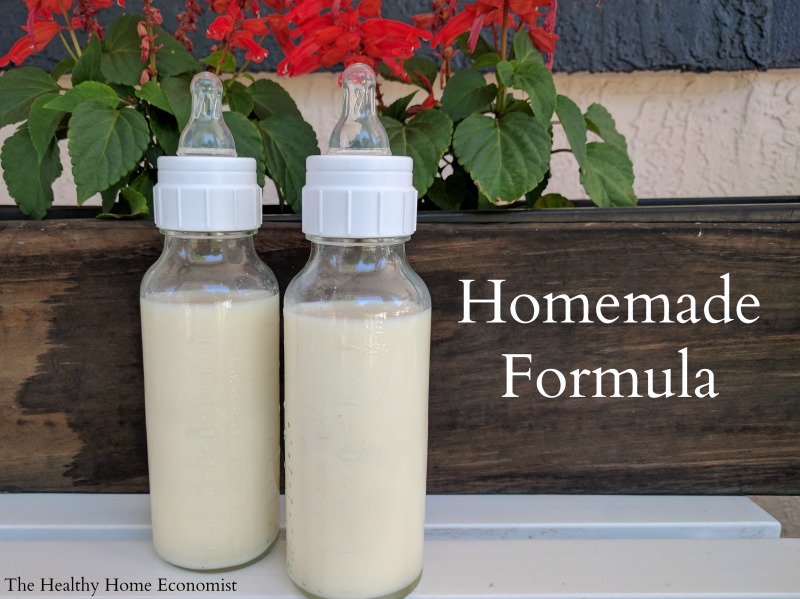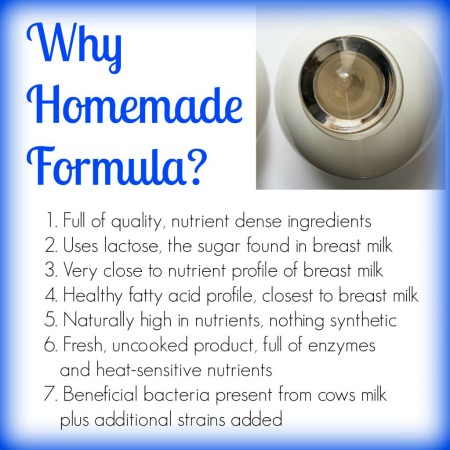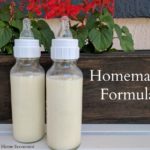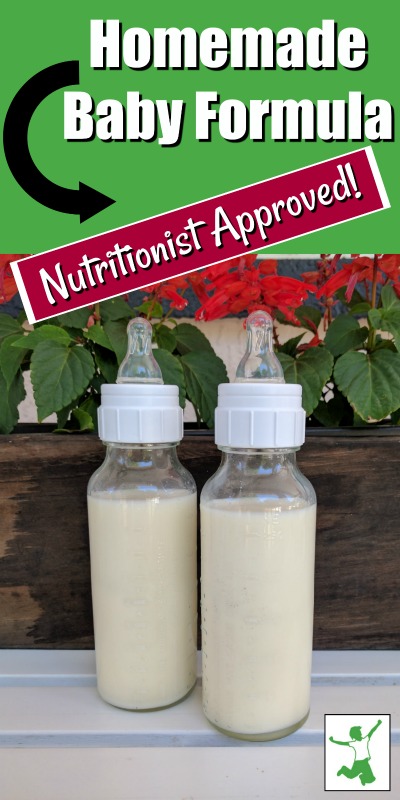Table of Contents[Hide][Show]
A nourishing homemade baby formula using safe, whole ingredients. This recipe was developed and tested by Dr. Mary Enig, a PhD Nutritionist and originally published in Nourishing Traditions cookbook in 1996. It was formulated to match breastmilk as closely as possible and is also suitable for infants. Source: Weston A. Price Foundation

There is no doubt that breastfeeding your baby is the best option for the child’s long-term health and development. Human breastmilk from a well-nourished mother is the perfect food for baby. However, in circumstances where the child is adopted or the Mother finds herself unable to breastfeed, formula feeding becomes necessary. In those cases, homemade baby formula is best.
Using a baby formula recipe that closely matches the nutritional profile of breastmilk is a far better choice than even organic baby formula from the health food store. More on this below.
Note: Donor programs are widely available for human breastmilk. But, the diets of the donor mothers are unknown and most likely nutritionally insufficient. In addition, breastmilk banks pasteurize the donated breastmilk which destroys much of the nutritional benefit. Unless you are fortunate to have a trusted and direct donor milk source in your community, avoid this option!
Dangers of Commercial Formula
Commercial formulas are always a poor choice for a number of reasons. First of all, formula manufacturers line the cans with the chemical BPA. This substance disrupts hormone development and is a probable contributor to early puberty in girls, and ADHD, urogenital abnormalities, and other ills in boys.
The European Food Safety Authority found that canned commercial formula is a significant source of BPA for infants, exposing the child to 13mcg of BPA per kg of body weight per day! BPA-free formula cans are no better. The chemical BPS is typically used instead which is just as dangerous.
Beware that manufacturers pack even organic commercial formula like Earth’s Best in BPA cans. Worse, they use organic brown rice syrup as the primary sweetener which is known to be frequently contaminated with arsenic.
In addition, all commercial milk formulas are processed at extremely high temperatures which violently denature the fragile milk proteins, render them allergenic, and add carcinogens to the final product. Soy infant formula is the worst. Obscenely high processing temperatures not only denature the proteins but large levels of phytic acid in soy block mineral absorption by the infant. Moreover, soy-based plant estrogens disrupt the hormonal development of the baby!
It seems that for the concerned Mother who is unable to breastfeed, learning how to make baby formula at home with safe, pure ingredients is the most prudent way to go!
Why Make Homemade Formula Even if You Are Breastfeeding
In the video below, I show you how to make your own safe, healthy raw milk homemade formula for your baby.
The recipe I follow was originally published in the cookbook Nourishing Traditions in 1996 and developed by Dr. Mary Enig.
Even though I breastfed each of my children for at least 2 years, I made this exact formula for my own children when I was away for the day or the evening as pumping was not an option that worked well for me.
I even used this homemade formula for an entire day once when I had some dental work done and was advised to pump and discard for 24 hours.
As a result, even successfully breastfeeding Moms can use this wonderful homemade formula as a supplement when necessary to their own nutrient-dense breastmilk!
It is advised that even breastfeeding Mothers have the ingredients for this formula on hand for an emergency. If Mom is sick or otherwise unable to nurse, Dad can step in and make this safe alternative until Mom is back on her feet. It takes a few days to a week to gather all the ingredients together to make this formula, which is why I advise having them on hand at all times.
Homemade Most Nutritious
The image below lists the reasons why it is worth it nutritionally to make formula yourself for your precious baby!
You can order all of the required ingredients for the homemade baby formula in one package from this reputable, vetted source.
Moms who have successfully used this formula feeding your children, please post about your experience in the comments section to encourage those who are considering it and need some Mom to Mom encouragement!

Where to Source Quality Milk
The most widely available grass-fed milk around the world is from cows. This is usually the most budget-friendly and easily sourced milk for this recipe for homemade formula.
If only goat milk is available in your area, this recipe for goat milk baby formula can be used instead. When using milk from ewes, please refer to the linked article for an adjusted recipe; one of the benefits of sheep milk is that it is higher in healthy fats than either goat or cow milk.
Camel milk formula is another option that is a particularly digestible form of dairy and growing in popularity around the world.
Alternatively, you can use low temp (vat) pasteurized, non-homogenized whole milk cultured with a piima or kefir starter. Then substitute the piima milk or kefir for the raw milk portion of the formula recipe. Cold-pressed raw milk also must be cultured before using it as it contains no probiotics.
Do NOT use ultrapasteurized (UHT) milk even if organic as it is too highly processed and extremely allergenic!
It is also best to avoid all types of powdered milk for this recipe. The factory process of making milk powder reduces nutrition considerably and denatures it, which makes it more likely baby will have an allergic reaction.
Dairy Allergy Option
If all types of dairy prove unsuitable for your baby, make this nondairy baby formula recipe instead. It uses a base of homemade bone broth as a substitute for milk. It is important not to utilize a plant-based or otherwise vegan baby formula recipe.
Avoid buying bone broth to make the dairy-free formula. Make it yourself! Manufacturers of commercial bone broth, even if authentic, may water down the end product. This is apparent if it does not gel when chilled in the refrigerator.
Many brands have toxic packaging issues as well. If you must buy it in a pinch, see my shopping guide page for vetted brands that are safe.

Homemade Baby Formula Recipe (for infants too)
A nourishing baby formula recipe you can make at home with safe, whole ingredients developed and tested by a PhD nutritionist to match breastmilk as closely as possible. Also suitable for infants.
Ingredients
- 2 cups raw cow milk OR organic whole milk yogurt
- 1 7/8 cups filtered water
- 1/4 cup liquid whey
- 4 Tbl lactose
- 1/4 tsp Bifidobacterium infantis powder
- 2-4 Tbl raw or pasteurized cream
- 1/2 tsp cod liver oil unflavored
- 1/4 tsp butter oil unflavored
- 1 tsp sunflower oil preferably organic
- 1 tsp extra virgin olive oil preferably organic
- 2 tsp virgin coconut oil preferably organic
- 2 tsp nutritional yeast
- 2 tsp gelatin
- 1/4 tsp acerola powder
Instructions
-
Fill a 2 cup Pyrex measuring cup with filtered water and remove 2 TBL (this will give you 1 7/8 cup water).
-
Pour about half the water into a pan and turn burner on medium.
-
Add the gelatin and lactose and let dissolve, stirring occasionally.
-
When gelatin and lactose are dissolved, remove pan from heat and add the rest of the water to cool.
-
Stir in the coconut oil and butter oil until melted.
-
Put remaining ingredients in a glass blender.
-
Add the water mixture and blend for about 3 seconds.
-
Place formula in glass baby bottles or a glass jar and refrigerate.
-
Before giving to baby, warm glass bottle in a pan of hot water or a bottle warmer. NEVER microwave baby bottles!
Recipe Video
Recipe Notes
If using raw cow milk from holstein cows, use 4 Tbl of extra cream (otherwise use 2 Tbl extra cream).
If choosing to make this homemade formula with camel milk, be sure to include 4 Tbl extra cream as camel milk is lower in cream than cow milk.
Do not use high oleic sunflower oil. Use only the brand recommended in the ingredients list which is cold pressed, organic, unrefined, and low oleic.
*Do NOT use powdered whey from the store as it is denatured. Avoid whey from making cheese as it will curdle the formula.
*Do not substitute pasteurized or powdered milk as these are heavily processed, denatured and allergenic foods.
*Do NOT use ultrapasteurized (UHT) cream. It is highly allergenic. Raw or pasteurized cream is acceptable.
*Do NOT use fish oil or krill oil instead of high vitamin cod liver oil as they do not contain any Vitamin D and very little to no Vitamin A.
Collagen powder may be substituted for the gelatin in a pinch (more on peptides in baby formula in this article).
If you are wondering where is the iron in homemade baby formula, this article provides an explanation.
If baby experiences constipation using this formula, try adding 1 tsp of molasses to each batch. This should help move things along.
How to Transition to DIY Formula
Once you’ve viewed the video, gathered the ingredients, and made your first batch, how do you feed it to your baby for the first time?
It is important not to switch all at once as this can cause gas, excessive spit-up, or an uncomfortable change in diaper habits such as constipation or overly loose stools.
Start by giving your baby three-quarters of the old formula blended with one-quarter of the homemade. Try this ratio for a day or two and see how your infant responds.
If no digestive upset or major change in diaper habits occurs, increase the amount to a 50-50 blend of old formula to homemade. Observe for another day or two as before.
If no major issues, increase once again to three-quarters homemade formula to one-quarter old formula. If baby does well on this blend for a third time, you are ready to fully transition to the homemade formula.
At any time during the transition, symptoms of intolerance emerge, back up to the previous successful blend ratio and stay there for a day or two before attempting to increase once again.
Homemade Formula FAQ
Weston Price Foundation
Feeding an Adopted Baby
Traveling Tips with Baby Formula Made at Home
Iron in Baby Formula
Collagen Peptides instead of Gelatin for Homemade Formula?










thank you so much for posting this! i have enjoyed reading everyone’s commentary 🙂 a friend encouraged me to try this formula as i was having some supply issues. as it turns out, delving into traditional foods for my baby’s sake has opened my mind up to feeding my whole family healthier!
I noticed that the link you have posted for the butter oil is a capsule. Is there a reason for that? Why not the liquid?
The liquid is fine too …. Perhaps the info in the link has changed since I wrote the post.
So what are you using in your video? the capsule? Is what is in the capsule powder or liquid?
Does this formula gives gas to baby?? i made it for my 2 month old and she seems to like it but after having her 1st formula feed(till now she was having one feed of store bought formula) she got gas and it was intense pain for about 11/2 hour. Is there a way to switch between breast milk(my supply seems to decrease) and homemade raw milk formula. She normally has 4 oz of breast milk so should I give her 4 oz of Homemade formula or less amount? Can you help me with the amount of formula to give as I have heard positive reviews about this homemade formula and would love if my baby has it.
Most lactation specialist (I am not one) would recommend that you increase the times you breastfeed, and possibly the length of your breastfeeding schedule, rather than to start supplementing. Supplementing will definitely decrease your breastmilk supply. A human breast requires stimulation to produce breastmilk.
Not trying to talk you out of anything. Just making sure that you understand that you will decrease your production more, if you begin to supplement. Another option would be to use an SNS (supplemental nursing system) and either this formula or other expressed breastmilk.
Babies will take their food in the easiest way provided; therefore since anything offered from a bottle, cup or spoon, is easier to drink, they will begin to prefer the “easier” food source.
Sarah,
Do you think it would be fine to give him 1 ml of FCLO per 3 ounces of this formula? I’m having a hard time figuring out how much and how often I should give him the FCLO. Also, I’ve tasted this formula several times but it tastes like spoiled milk, is that because of the Nutritional Yeast? The raw milk I used was from a fresh batch.Thanks!
It tastes soured because of the whey that is added. Your taste buds and your baby’s are going to perceive it quite differently, so no worries. REmember your baby has never had sugar or processed foods before, so things will be much sweeter to him than to you.
We recently adopted our first child and for the first two weeks he had breastmilk that my gracious sister-in-law had pumped for us. Our son has a very healthy appetite and we started the raw milk formula after we ran out of the breastmilk, and at seven weeks he now weighs over 12 lbs. The one concern I have is he seems to get constipated and his bm seems to be painful for him. Is there anything I can do to help him with this?
Hi Lydia, refer to the comments above .. if you substitute raw kefir or raw yogurt for the 2 cups of raw whole milk this has a good chance to relieve the problem.
Sarah, Is it ok to start my 1 month old baby on this formula? If so, can I leave out the Cod Liver Oil of the formula and give it to him seperately, if so; how much CLO do you recommend I give him daily?
Hi Dede, yes – this formula is fine for newborns. If you are going to give him the FCLO separately, I would give him the equivalent of how much cod liver oil would be in the homemade formula based on the per ounces per day he is currently drinking. Then, it would slowly increase as he grows.
Sarah,
Do you think it would be fine to give him 1 ml of FCLO per 3 ounces of this formula? I’m having a hard time trying to figure out how much and how often I should give him the FCLO. Thanks!
I think you should add the FCLO to the formula per the amount and directions in the recipe and do it that way. This way, there are no mistakes and no accidental forgetting to give it to him.
Can someone please email me the RAW YOGURT based formula recipe? ([email protected]) I prepared the original recipe but it constipated my 1 month old for about two weeks. I am now stuck with a 6 month supply of product (lactose, gelatin ect…), and I do not know what else to do to make my baby like this formula. HELP!
Hello. Can you please tell me about how much this formula would cost to make in comparison to store bought organic formula. I know I will be making this for my baby when she gets here but we are trying to make a budget so it would be great if I could know the cost. Thank you so much for all your help in this area.
Elizabeth Ewing
Hi Elizabeth, the cost would vary considerably based on how much you are able to source raw milk per gallon. Raw milk prices vary greatly .. from $4/gallon to $15 or more per gallon.
Sarah – We have made the formula using your direction. The formula is not white – but more a tan or beige. We use farm fresh raw milk and ordered the exact ingredients you recommend. The formula also appears to “separate” slightly. We are using it within a few days of making it. Tell me, please, if this is what you would expect. Thank you.
Yes, beige is fine .. this indicates good quality grassfed cream/milk. You should really make it every day if this is the only source of food for your baby. Every other day at the most.
Hi Sarah,
Our baby is only 10 days old and so eats only a small amount per serving. 36 ounces is too much to make every day or every other day. Is this meant for older infants?
Or is it expected to just half the recipe for new borns?
Also the formula had a strong rotten smell the next morning.
The raw milk was about 5 days old and still smelled fresh when used.
Could this be from the yeast or bifidum?
How strong should i expect the formula to smell the next day.
Thank you for your blog,
Marko
can I add something else to the formula to substitute those things?
go to the weston a price website, they have two other formulas that might work for you. also read their FAQs page, it answers lots of questions. i know this comment is old, but for anyone else searching now, like me, it will help.